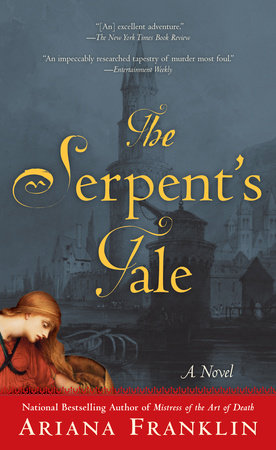The Serpent’s Tale Reader’s Guide
By Ariana Franklin


INTRODUCTION
High in the upper chamber of Wormhold Tower—a monolithic structure located in the countryside of medieval Oxfordshire—a woman lies dying. Having exhausted her prayers to God, the attending nun, Sister Havis of nearby Godstow Abbey, calls for a priest to administer last rites. The dying woman’s pathologically devoted servant, Dame Dakers, appeals to a different power to save her master’s life, performing a ritual sacrifice to the Devil. But neither God nor the Devil can rescue the woman from an agonizing death, or shield England from the political firestorm that is sure to follow. For the woman writhing in her deathbed is Rosamund Clifford, famed mistress of King Henry II, and her death is no accident. And with Henry’s rebellious wife Eleanor freshly escaped from imprisonment, there seems little doubt of the culprit—and little hope of averting a civil war that will tear England to shreds.
Ariana Franklin’s The Serpent’s Tale features the return of Adelia Aguilar, hero of Mistress of the Art of Death. Thanks to her training at the forward-thinking School of Medicine in her native Salerno, Adelia is an alien in medieval England: a skilled forensic investigator in an age of ignorance and superstition, an educated and fiercely independent woman in a culture that considers women little more than property. She is now also the mother of an infant daughter, conceived during her brief but intense love affair with Rowley Picot, the newly appointed bishop of St. Albans. Barred from returning to her native Italy by King Henry himself —who sees her as a valuable, if largely neglected, resource—Adelia has come to feel at home among the fen people of Cambridgeshire. She has also convinced herself that her feelings for Picot have been extinguished, a self-deception that is quickly exposed when the bishop summons her to Cambridge. Adelia initially refuses to answer the call of the man who fathered her child and then retreated into a life of sanctity and celibacy. But Picot’s need for her is dire. Only Adelia has the knowledge and skills to prove Eleanor innocent of Rosamund’s murder, and only Eleanor’s exoneration will prevent Henry from unleashing a torrent of military retribution against her and her nascent army.
The Serpent’s Tale broadens the canvas from Adelia’s previous adventure, moving the action west to Oxfordshire and interweaving her story with the legendary tale of Henry Plantagenet and Eleanor of Aquitaine. Adelia’s investigation pits her against obstacles both manmade and natural, including the serpentine labyrinth surrounding Wormhold Tower and the harrowing snowstorm that smothers the countryside after she is captured by Eleanor. Forced to take shelter at Godstow Abbey, Adelia finds herself short on allies and surrounded by threats: the violently bickering factions of Eleanor’s mercenary army, the superstitious townspeople who suspect her as a witch, and an assassin who is systematically murdering anyone who might identify him. Desperate to protect her child but also determined to provide justice for the dead, Adelia once again finds herself face-to-face with a killer—and dangerously close to becoming his next victim.
Just for joining you’ll get personalized recommendations on your dashboard daily and features only for members.
Find Out More Join Now Sign In